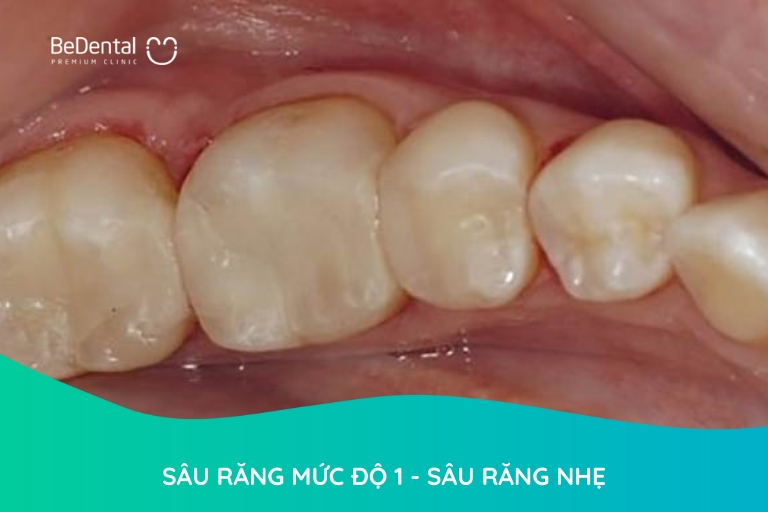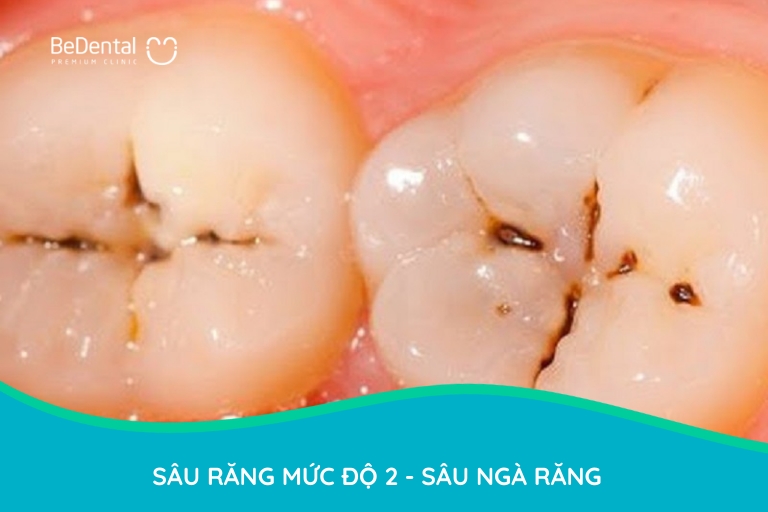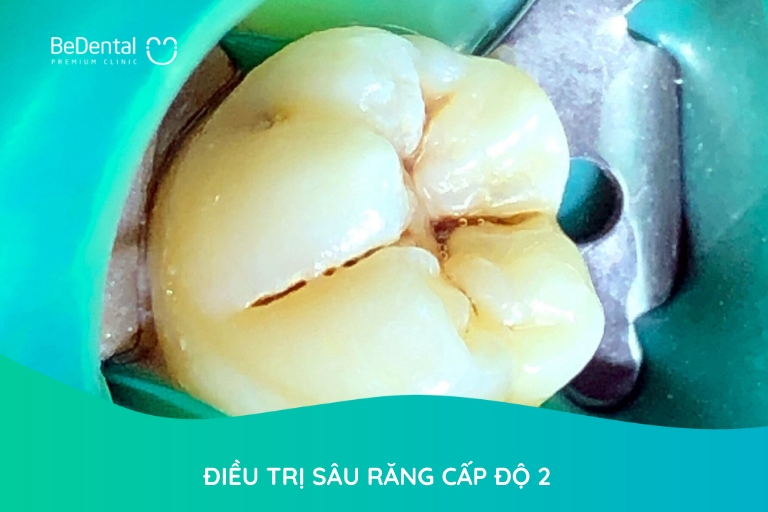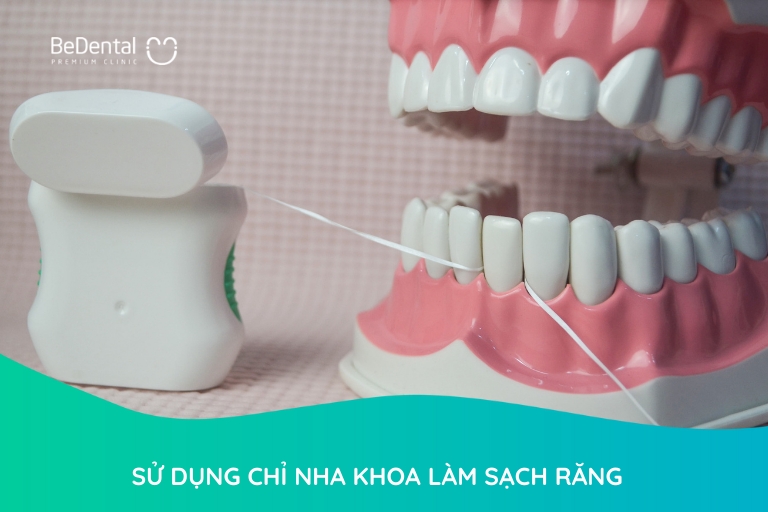3 Levels of Tooth Decay: Causes, Treatments and Prevention Measures
Tooth decay is a common dental condition in people and is categorized into various levels. Each level of tooth decay requires different treatment measures. In this article, Bedental will help you understand 3 levels of tooth decay and suggest some appropriate treatment methods.
Summary about 3 levels of tooth decay you should know!
The level of tooth decay is not determined based on specific formulas but rather on a decay stage. Dentists assess the extent of tooth damage to determine the level of tooth decay. There are three levels of tooth decay:
Tooth decay Level 1: Demineralization (Initial Stage of Decay)
The first stage of tooth decay is known as demineralization. This stage is also referred to as incipient decay or more commonly, “white spots”. In this stage, we see the first signs that a tooth is under attack by the acids. Enamel is the toughest substance in your body — harder than your bones. However, the acid produced by plaque can demineralize and weaken enamel. This white spot is caused by bacteria that sits on the tooth for too long. The bacteria consume sugars in the food and drinks that we consume and produce an acidic byproduct which works to weaken the tooth’s structure.

During this stage, people may not yet experience pain from bacterial invasion or sensitivity to hot and spicy foods. If there is any discomfort, it is usually mild and not noticeable.
Signs of tooth decay level 1:
Initially, the tooth may start to show a yellowish tint, and there may be small white spots or tiny black spots on the chewing surfaces. These markings are limited to the chewing surfaces of the tooth. At this stage, bacteria have not yet destroyed the enamel or penetrated deep into the tooth.
Diagnosing tooth decay level 1:
To accurately diagnose level 1 tooth decay, dentists may use air to dry the potentially affected tooth surface. This helps identify white spots or other lesions on the tooth. This method is considered to have an accuracy rate up to 90%.
If white spots or small markings are visible on the tooth surface, it indicates the presence of decay that can be promptly treated with targeted medications. However, if these markings are visible to the naked eye without the need for air drying, it may be more challenging to treat.
Remember, maintaining good oral hygiene and having regular dental check-ups are crucial for early detection and effective treatment of incipient decay.
Tooth decay Level 2: Enamel Decay
Level 2 tooth decay is a condition where the enamel has deteriorated, forming visible cavities on the tooth surface that can be observed clearly. The development of cavities is often a result of untreated white spots in the early stages.
Bacteria attack the tooth enamel, causing its loss and leading to the formation of cavities. During this stage, individuals may experience prolonged toothaches and sensitivity. However, the pain may not be constant but triggered, for example, by eating hot or cold food.

Signs of tooth decay level 2:
Black or yellowish decayed areas, typically around 2mm in size, become visible.
Diagnosing tooth decay level 2:
- Visual Diagnosis: At this stage, decay is visible to see. Cavities may appear yellow or black, indicating a more advanced stage of tooth decay.
- Diagnosis using a dental Explorer Probe: Dentists use an explorer probe, a dental instrument, to identify rough surfaces indicating decay beneath the tooth’s surface and soft dentin layers. This method is used when the decay has not reached the tooth’s pulp.
Note: For children who haven’t yet experienced primary tooth loss, distinguishing between deep dentin and emerging teeth can be challenging. Injuries caused by emerging teeth typically originate from the outside of the tooth and spread to the sides of the adjacent teeth. Decay-induced damage, on the other hand, starts externally and progresses towards the tooth’s base. Injuries caused by emerging teeth may also exhibit dark pigments on the tooth surface but usually do not cause pain. Therefore, accurate symptom identification is crucial to avoid misdiagnosis and ensure appropriate treatment.
Tooth decay Level 3: Damaged Pulp
If tooth decay level 2 is not treated promptly, bacteria will rapidly destroy the dentin layer. Bacteria penetrate, causing severe decay with damaged pulp. At this stage, the cavities are relatively large due to the deep deterioration of the tooth structure. This is considered a severe condition of tooth decay. The tooth pulp, containing numerous nerves, is invaded by bacteria, leading to bad breath.

During this stage, decay-causing bacteria attack the oral cavity, directly infiltrating the tooth pulp, resulting in intense and persistent toothaches. When facing this situation, it is crucial to promptly seek dental treatment to prevent acute pulpitis. Additionally, the affected tooth may become more sensitive to external stimuli, and toothaches may be accompanied by mild fever, impacting your ability to chew.
Signs of tooth decay level 3:
Level 3 tooth decay is distinguished from level 2 by the depth of the cavity. If the cavity is deeper than 2mm, it indicates level 3 tooth decay.
Diagnosing tooth decay level 3:
- Visual Diagnosis: Dentists visually inspect the size of the cavity. If the cavity is substantial, measuring 3-4mm or more, it suggests severe damage.
- Water Spraying Method: Dental professionals may use a water spray to assess the depth and pain associated with the tooth decay.
- Dental X-rays: Taking dental X-rays is the most accurate method to determine the extent of severe tooth decay.
In addition to the commonly known 3 levels of tooth decay, there is a more severe condition known as level 4, where the tooth pulp is extensively damaged, leading to abscess formation. Level 4 tooth decay involves significant deterioration, protrusion of the pulp, fracture of the tooth body, leaving only the tooth root, causing tooth loss.
Causes of the 3 levels of tooth decay:
The primary cause of the three levels of tooth decay is the accumulation of food particles on the teeth without proper hygiene. This creates conditions for bacteria that cause tooth decay to thrive and erode the tooth enamel.
In addition to poor oral hygiene, there are other factors contributing to tooth decay, such as:
- Age: Older individuals are more susceptible to tooth decay. As one ages, the oral health tends to weaken, making it easier for bacteria to attack the tooth enamel.
- Underlying Medical Conditions: Individuals with conditions like hypertension, diabetes, etc, have a higher risk of tooth decay. These health issues can affect the overall oral health.
- Pregnancy: Pregnant women with tooth decay may impact the absorption of calcium for the baby, potentially leading to weaker oral health for the child.
- Children with Primary Teeth: Children who have not yet replaced their primary teeth are more prone to tooth decay. Primary teeth have weaker and softer enamel compared to permanent teeth.
- Dry Mouth: Saliva plays a crucial role in preventing the buildup of plaque and cleaning food particles, inhibiting bacterial growth. Therefore, a dry mouth can be a contributing factor to tooth decay.
Treatment for 3 levels of tooth decay:
Here are some suggestions to treat tooth decay depends on level:
Treatment for Level 1 Tooth Decay:
- For early-stage tooth decay, dentists may use a mixture containing calcium, phosphate, and fluoride applied to the affected area. This method, known as tooth remineralization, helps narrow the white spots on the teeth and prevents the further development of tooth decay.
- Dentists may also prescribe medication for tooth decay, especially when it affects the chewing surfaces. This is applicable when teeth have small areas turning black but bacteria have not penetrated deep inside.
Treatment for Level 2 Tooth Decay:

- When bacteria create cavities on the teeth, conventional methods are not sufficient, and restorative methods are needed.
- Dentists will remove the decayed part of the tooth and then restore it using methods like dental fillings or dental crowns. The choice of method depends on individual needs and financial capabilities.
Treatment for Level 3 Tooth Decay:
- If the decay reaches the tooth pulp, a more comprehensive approach is needed. Dentists may perform a root canal before applying restorative methods.
- In cases where the pulp is not thoroughly cleaned, additional treatments may be necessary. If the pulp is not cleaned completely, the condition of tooth decay may persist.
- Dentists will treat by cleaning the root canal. Then, a substance is placed in the root canal to replace the pulp. Subsequently, the tooth is restored using methods such as dental bonding or dental crowns.
- In cases of dead pulp, where bacteria invade the pulp chamber, breaking the body of the tooth and leaving only the root, dentists will remove the decayed tooth to prevent further bacterial invasion and potential blood infections. After the removal, it’s recommended to implant a dental prosthesis to fill the gap, ensuring normal development of the jawbone and preventing misalignment.

5 ways to prevent tooth decay:
To prevent tooth decay, you should regularly follow these :
5 ways to prevent tooth decay: Proper Tooth Brushing:
Brush your teeth at least 2 times a day, before going to bed, after waking up, or after meals.
Brush your teeth correctly by holding the toothbrush at a 45-degree angle, with the bristles directed towards the gums. Move the brush up and down along the tooth surface, then rotate and gradually move outward. Avoid brushing horizontally.
5 ways to prevent tooth decay: Use Dental Floss:
Dental floss can clean 75% of food debris on the teeth, while 25% of the debris between teeth may remain uncleaned. Therefore, use dental floss to clean between your teeth.

5 ways to prevent tooth decay: Develop the Habit of Using Mouthwash:
Mouthwash containing fluoride helps freshen your breath and strengthens your teeth.
5 ways to prevent tooth decay: Limit Consumption of Sugary Snacks:
Foods like cakes, candies, and soft drinks contain high levels of chemical sugars. Inadequate cleaning after consuming such snacks provides favorable conditions for the superior growth of bacteria, leading to tooth decay.
5 ways to prevent tooth decay: Regular Dental Check-ups:
Schedule dental check-ups every 6 months to detect and treat tooth decay promptly. This helps you address dental issues, avoiding tooth loss, and reducing treatment costs.
As for the duration of tooth decay development, it is relatively slow. The three levels of tooth decay can take from 2 to 4 years to progress. Tooth decay from level 1 to level 2 may advance within 6 months to 1 year, or even up to 2 years. Therefore, it is essential to seek prompt treatment upon detecting tooth decay to prevent issues such as tooth loss, toothaches, and adverse effects on other teeth.
Conclusion
Protect your oral health as well as your overall body health. While tooth decay is just one dental condition that anyone can encounter, it can cause various repercussions for your health if not treated correctly and timely. Contact BeDental today for further advice on tooth decay and other dental conditions.
Tư vấn chuyên môn bài viết:
BÁC SĨ DƯƠNG THỊ THÙY NGA





